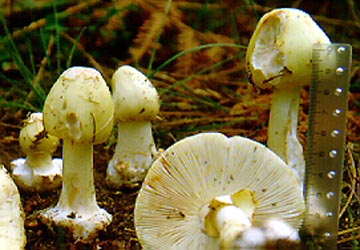|
[ Section Validae page. ] [ Amanita Studies home. ] [ Keys & Checklist/Picturebooks ] Amanita asteropus Sabo ex Romagn."European Star-footed Amanita"
Technical description (t.b.d.) BRIEF DESCRIPTION: Fruiting body dimensions are taken from Traverso (1999). All parts of the fruiting body bruise/stain reddish or orangish brown when damaged. The cap of A. asteropus is 60 - 120 mm wide and ranges from cream with a butter yellow tint in the center to ivory white to pale butter yellow. When moist it is slightly viscid. At first the cap is bell-shaped, then convex, and finally planar with an umbo. It can be convex in age. The volva is often absent from the cap but sometimes appears as submembranous, pale-ochraceous plaques. The gills are free and white at first, then cream. The stem of A. asteropus is 100 - 150 x 15 - 20 mm, white to pale yellow, and bears a superior annulus that is white above and may be pale yellow below. Some sources say that the annulus is sometimes quite fragile. The stem's bulb is roughly hemispherical and split vertically on the sides giving it a star-shaped cross-section when cut perpendicular to the axis of the stem. The volva is white to yellowish at first and is fragile and easily left in the substrate when the species is collected. Amanita asteropus (especially in the base of the stem) has the odor of radish or raw potato when young. It has no appreciable taste. The white spores measure (6.8-) 7.3 - 10.1 (-14.5) x (6.0-) 6.9 - 9.2 (-11.6) Ám and are globose to subglobose (infrequently broadly ellipsoid or ellipsoid) and amyloid. Clamps are absent from the bases of basidia. The species was originally described from France (Gironde) and is known from southern Europe. Oddly, neither author gave macroscopic dimensions for any part of the fruiting body. Amanita asteropus is associated with oak, either in pure groves or in mixed forests. Its segregation from A. aestivalis Singer was demonstrated by Tulloss and Massart (1998). The species differ at least in the color of the fruiting body and in their reactions to macrochemical tests (e.g., when 1% paracresol solution is applied to a cross-section of the fruiting body of A. aestivalis there is no reaction; but when the same is done to A. asteropus, the entire cross-section becomes red-brown -- positive for the presence of tyrosinase). Another species to compare with A.
asteropus is A. brunnescens G. F. Atk. Photo courtesy of Francis Massart (southern France). [ Section Validae page. ] [ Amanita Studies home. ] [ Keys & Checklist/Picturebooks ] Last changed 28 September 2009. |
